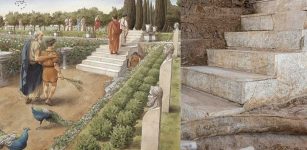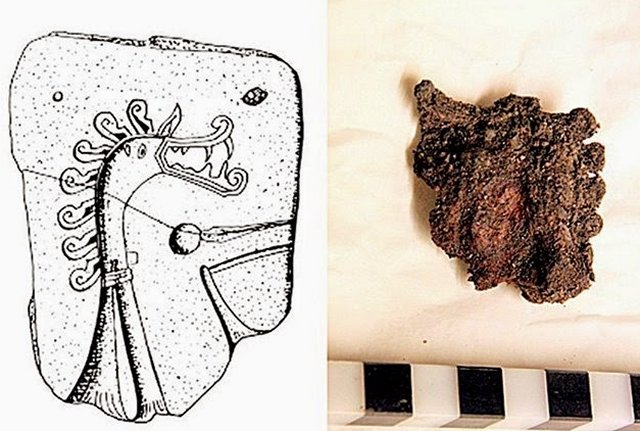Birka Artifacts Shed Light On Vikings’ Daily Life
Ellen Lloyd - AncientPages.com - Ancient artifacts discovered at Birka offer valuable information about Vikings’ daily life.
By examining several of the objects unearthed at Birka, one can get a unique glimpse into the beliefs, practices, and traditions of the Vikings.
Birka is located on the small island of Björkö (‘Birch Island’) on Lake Mälaren, Ekerö, Sweden.
A reconstructed Viking house at Birka. Credit: Claes Helander
Today, the place is not as famous as it once was in ancient times. During the Viking Age, Birka was a major trading center and an important trade hub for goods from Scandinavia, Central and Eastern Europe, and the Orient.
People representing many ancient cultures visited Birka, where they sold and bought goods. Birka was also the site of the first Christian gatherings in Sweden, organized in 831 by Saint Ansgar, a nobleman.
A reconstruction of Birka.
Archaeologists excavating at Birka have made many interesting finds that challenge historians’ understanding of the Viking society. For example, it was long assumed that Viking women couldn’t be warriors. This is wrong, however. During the Viking Age, females took part in battles, and women could become great warriors. This was confirmed when scientists found an intriguing grave at Birka. Inside the grave, researchers found a skeleton, various weapons, including a sword and armor-breaking arrows, a horse, and a board game.
Archaeologists thought these were the remains of a male Viking warrior of great military importance. Later, a comprehensive DNA study revealed the Birka warrior was in fact a woman. This discovery also suggests that mythical female warriors known as Shield-Maidens may have been the basis for the mythical ‘Valkyries.’
Left: This is how the tomb at Birka possibly looked like. The grave plan was created by Evald Hansen and based on the original plan from grave Bj 581 from Hjalmar Stolpe's excavations at Birka in the late 1800s (Stolpe 1889). Right: The drawing is a reconstruction of how the grave with the woman originally may have looked. The illustration was made by Þórhallur Þráinsson © Neil Price
Like many ancient civilizations, Vikings used several symbols that had special significance. Viking symbols were based on Norse mythology. Symbols played a vital role in Viking society and were used to represent their gods, beliefs, and myths.
One of the most important Viking symbols was the dragon. Many Viking ships were equipped with carved dragonheads on top of the stem, while the stern often was shaped like a dragon's tail.
The discovery of the dragon's head is one of the most exciting finds in recent years.
In Birka, archaeologists found evidence that the dragon played a vital role in the daily life of the Vikings. While excavating in the ancient town, scientists came across a little dragon's head that had been on an ancient costume needle, but the needle had long disintegrated.
Vikings traded with many ancient civilizations, and they were curious about distant and exotic cultures' beliefs and traditions. While examining a ninth-century ring from Birka, scientists concluded the artifact came directly from the Islamic civilization. The ring includes an inset of colored glass engraved with ancient Arabic script.
An inscription on the glass inset reads either “for Allah” or “to Allah” in an ancient Arabic script.
Veronica Björkman, who works as a destination chef and guide in Birka, says people who lived in this ancient city were similar to modern people. These individuals could be happy or sad, and they loved their children, but of course, there were some differences, and life for youngsters was much tougher.
Decorated comb. Credit: Birka site museum.
Cast copper alloy brooch. Credit: Birka site museum
Like most children of the ancient world, Viking children did not have much time to enjoy their childhood. Work, learning, duties, and responsibility started at a very early age, and there was not much time for playing games, but this does not mean it was boring to be a Viking child. It was simply different than it is today. Viking parents loved their children so much that they buried them with extremely sharp knives. These knives have been debated, but some scholars suggest they were intended as tools for the afterlife.
Björkman also point out that the “Allah” ring discovered in Birka is also one of several proofs that trade and meetings with the Arab world occurred.
The magnificent ancient jewelry discovered at the site offers evidence Vikings were excellent craftsmen. Ancient Viking jewelry was in most cases, made of silver or bronze and sometimes gold. Many Viking ornaments featured images of animals, particularly twisting shapes of snakes.
Some years ago, using ground-penetrating radar, scientists made another fascinating discovery at Birka. High resolution geophysical surveys revealed a major Viking period hall on the site, with a length of around 40 meters. Based on the land upheaval, the area of the Viking hall can be dated to sometime after 810 AD. According to archaeologists, the Viking mason was owned by a man called Herigar, who was one of the King’s representatives. Herigar is mentioned in several historical sources.
Sometimes called Sweden’s first city, Birka lost its significance when Christianity spread across the country. The town was abandoned and ceased to exist as a manufacturing and commercial center around 960 A.D. but the island of Björkö was continuously inhabited. Another town, Sigtuna, located further north in Stockholm county became a replacement for Birka’s trade activities.
There are approximately 4,000 ancient graves in Birka, and still much to explore. Perhaps, archaeologists will find more intriguing ancient artifacts that will give us an even better understanding of Viking history.
Hedeby and Kaupang are other highly significant ancient trading centers where valuable Viking artifacts have been unearthed.
Written by Ellen Lloyd – AncientPages.com
Updated on September 23, 2022
Copyright © AncientPages.com All rights reserved. This material may not be published, broadcast, rewritten or redistributed in whole or part without the express written permission of AncientPages.com
More From Ancient Pages
-
 Oldest Known Projectile Points In The Americas Discovered In Idaho
Archaeology | Dec 23, 2022
Oldest Known Projectile Points In The Americas Discovered In Idaho
Archaeology | Dec 23, 2022 -
 Castro People: Intriguing Life Of The Female-Dominated Society In Ancient Iberia
Featured Stories | Oct 23, 2024
Castro People: Intriguing Life Of The Female-Dominated Society In Ancient Iberia
Featured Stories | Oct 23, 2024 -
 1,800-Year-Old Entrance To Turkey’s Zerzevan Castle Found Among The Ruins
Archaeology | Aug 15, 2020
1,800-Year-Old Entrance To Turkey’s Zerzevan Castle Found Among The Ruins
Archaeology | Aug 15, 2020 -
 African Skeletons From Early Colonial Mexico And First-Generation Slaves
Archaeology | May 4, 2020
African Skeletons From Early Colonial Mexico And First-Generation Slaves
Archaeology | May 4, 2020 -
 Choctaw Indians’ Legend Of Nanih Waiya Cave Mound – Mysterious Underground Realm Of Their Ancestors And Their Battle With Giants
Featured Stories | Aug 3, 2017
Choctaw Indians’ Legend Of Nanih Waiya Cave Mound – Mysterious Underground Realm Of Their Ancestors And Their Battle With Giants
Featured Stories | Aug 3, 2017 -
 Clovis People Invented ‘Fluting’ Ancient Stone Weaponry
Archaeology | Apr 5, 2017
Clovis People Invented ‘Fluting’ Ancient Stone Weaponry
Archaeology | Apr 5, 2017 -
 Lavish Home And Exotic Garden Of Emperor Caligula Discovered In Rome
Archaeology | Nov 19, 2020
Lavish Home And Exotic Garden Of Emperor Caligula Discovered In Rome
Archaeology | Nov 19, 2020 -
 Solar Eclipses And New Attempt To Date Homer’s Iliad And Odyssey
Myths & Legends | Jan 7, 2016
Solar Eclipses And New Attempt To Date Homer’s Iliad And Odyssey
Myths & Legends | Jan 7, 2016 -
 Discovery Of Roman Settlement, Workshops And Artifacts Will Shed Light On Their Life In Northern England
Archaeology | Apr 13, 2017
Discovery Of Roman Settlement, Workshops And Artifacts Will Shed Light On Their Life In Northern England
Archaeology | Apr 13, 2017 -
 What Can The 3D Reconstruction Of The Principia At Novae Reveal About Roman Propaganda?
News | Sep 16, 2023
What Can The 3D Reconstruction Of The Principia At Novae Reveal About Roman Propaganda?
News | Sep 16, 2023 -
 Hidden Double Message Discovered On Ancient Clay Tablet Gives A Disturbing Account Of The Great Flood
Archaeology | Dec 5, 2019
Hidden Double Message Discovered On Ancient Clay Tablet Gives A Disturbing Account Of The Great Flood
Archaeology | Dec 5, 2019 -
 The Burnt City And Its Mysterious Prehistoric Inhabitants
Civilizations | Nov 17, 2014
The Burnt City And Its Mysterious Prehistoric Inhabitants
Civilizations | Nov 17, 2014 -
 Unknown Purpose Of The Mysterious Huge Iron Age Ceramic Sharjah Jar Puzzles Scientists
Archaeology | Oct 7, 2022
Unknown Purpose Of The Mysterious Huge Iron Age Ceramic Sharjah Jar Puzzles Scientists
Archaeology | Oct 7, 2022 -
 DNA Study Sheds New Light On The Mysterious 9,000-Year-Old Shaman Burial In Bad Dürrenberg
Archaeology | Nov 29, 2023
DNA Study Sheds New Light On The Mysterious 9,000-Year-Old Shaman Burial In Bad Dürrenberg
Archaeology | Nov 29, 2023 -
 Mystery Of The Ancient Okunev Culture: Skeleton Of 4,500-Year-Old Noblewoman With Links To Native Americans Discovered In Siberia
Archaeology | Sep 9, 2016
Mystery Of The Ancient Okunev Culture: Skeleton Of 4,500-Year-Old Noblewoman With Links To Native Americans Discovered In Siberia
Archaeology | Sep 9, 2016 -
 World’s Oldest Mercury Poisoning Revealed In Copper Age Iberia
Archaeology | Nov 16, 2021
World’s Oldest Mercury Poisoning Revealed In Copper Age Iberia
Archaeology | Nov 16, 2021 -
 Hippocrates Didn’t Write The Oath, So Why Is He The Father Of Medicine?
Featured Stories | Oct 7, 2015
Hippocrates Didn’t Write The Oath, So Why Is He The Father Of Medicine?
Featured Stories | Oct 7, 2015 -
 Riddle Of The Hanging Gardens Of Babylon – Ancient Place Still Shrouded In Mystery – Part 1
Ancient Mysteries | Jun 7, 2019
Riddle Of The Hanging Gardens Of Babylon – Ancient Place Still Shrouded In Mystery – Part 1
Ancient Mysteries | Jun 7, 2019 -
 Never-Ending Battle Of The Oak King and Holly King – Confrontation Of The Light And The Darkness
Celtic Mythology | Dec 17, 2021
Never-Ending Battle Of The Oak King and Holly King – Confrontation Of The Light And The Darkness
Celtic Mythology | Dec 17, 2021 -
 Sam Bass Became Texas’s Beloved Bandit And Was Admired By The Poor
Featured Stories | Mar 23, 2021
Sam Bass Became Texas’s Beloved Bandit And Was Admired By The Poor
Featured Stories | Mar 23, 2021








